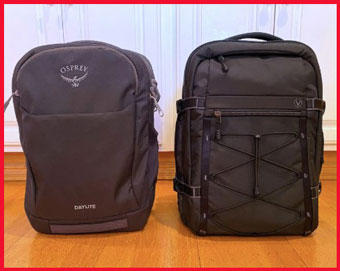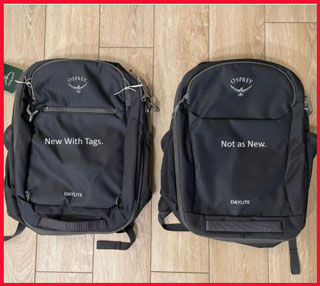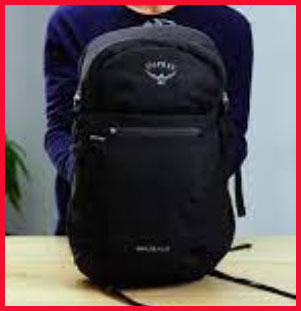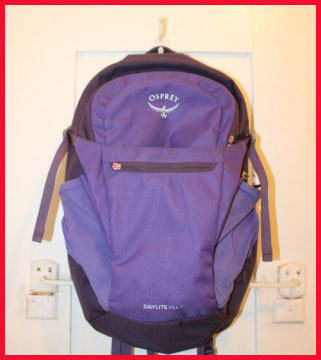I’m standing in the middle of an outdoor gear store, surrounded by a sea of backpacks, my head spinning. I need a reliable travel companion for my upcoming adventures—something that can handle bustling airports, rugged trails, and everything in between. Two brands keep catching my eye: Cotopaxi and Osprey. Both are giants in the outdoor world, but which one’s right for me? In this article, I’ll compare Cotopaxi and Osprey backpacks, breaking down their pros, cons, and key features to help you pick the perfect pack for your journey. Let’s get started.
A Brief Comparison Table
| Feature | Cotopaxi Allpa 35L | Osprey Farpoint 40L |
| Capacity | 35L (also 28L, 42L options) | 40L (also 55L, 70L options) |
| Weight | 3.8 lbs (35L) | 3.5 lbs (40L) |
| Material | TPU-coated 1000D polyester, 840D nylon | 450D recycled polyester |
| Organization | Multiple mesh pockets, clamshell opening | Single large compartment, compression straps |
| Comfort | Basic harness, non-adjustable | Adjustable torso, superior suspension |
| Durability | High (TPU coating, ballistic nylon) | High (recycled polyester, lifetime warranty) |
| Style | Vibrant, colorful, unique designs | Outdoorsy, functional aesthetic |
| Price | ~$200 (often discounted) | ~$185 (frequent sales) |
| Sustainability | Recycled materials, 1% to charity | Recycled fabrics, lifetime repairs |
| Warranty | 1-year warranty, ethical focus | All Mighty Guarantee (lifetime repairs) |
My Journey With Cotopaxi And Osprey
Read More: My Thought onTimbuk2 Vs. Tumi
As a frequent traveler, I’ve schlepped my gear through crowded train stations, hiked dusty trails, and navigated chaotic airports. A good backpack isn’t just a bag—it’s a lifeline. Cotopaxi and Osprey have earned their stripes in the travel and outdoor gear world, but they cater to slightly different vibes. Cotopaxi’s bold colors and sustainability focus scream adventure with a conscience, while Osprey’s technical prowess and comfort make it a go-to for serious trekkers. I’ve tested both brands extensively, and here’s what I’ve learned about their strengths, weaknesses, and what makes them tick.
Cotopaxi: The Vibrant, Organized Choice

Cotopaxi’s Allpa series, especially the 35L, feels like it was designed by someone who gets how chaotic travel can be. The first time I unzipped an Allpa, I was blown away by its suitcase-like clamshell opening. It’s a game-changer—everything’s visible, no digging required. The bag’s divided into mesh compartments, almost like built-in packing cubes, which makes organizing clothes, toiletries, and gadgets a breeze. I tossed in four days’ worth of clothes, a laptop, and travel essentials, and everything had its place. No more rummaging for socks at the bottom of a black hole.
The materials? Tough as nails. The TPU-coated 1000D polyester and 840D ballistic nylon give it a rugged edge, and I’ve dragged mine through rain and rough terrain without a scratch. Cotopaxi’s “Gear for Good” philosophy also resonates with me. They use recycled materials and donate 1% of sales to their foundation, supporting poverty alleviation. It’s not just a bag; it’s a statement. Plus, the Del Día versions—made from remnant fabrics—are one-of-a-kind, with vibrant, patchwork-like designs that turn heads at the airport.
But it’s not all sunshine. The Allpa’s harness system is basic. It’s fine for short walks, but after 30 minutes with a fully loaded 35L pack, my shoulders start to ache. The straps aren’t adjustable for torso length, which can be a dealbreaker for smaller or taller folks. I’m 5’7”, and it fits me decently, but my shorter friend felt like a turtle carrying a house. Also, the water bottle pocket is snug—my 20-ounce Hydro Flask barely fits, and anything bigger is a no-go. If you’re planning long treks or need a pack for petite frames, you might want to look elsewhere.
Osprey: The Comfort King
Osprey’s Farpoint 40L, on the other hand, feels like it was engineered for comfort. The first time I slung it on, I noticed the difference. The suspension system is top-notch, with padded shoulder straps, a breathable back panel, and an adjustable torso length—rare for a travel pack. I walked through Lisbon’s cobblestone streets for hours with 30 pounds on my back, and it felt like a breeze. The hip belt distributes weight beautifully, making it ideal for those long travel days when you’re stuck carrying your pack from morning to night.
The Farpoint’s design leans utilitarian. It’s a single large compartment with internal compression straps, which is great if you love packing cubes but less ideal if you want built-in organization. I tossed in my gear, cinched it down, and everything stayed secure, but I had to hunt for smaller items like chargers. The 450D recycled polyester is durable, and Osprey’s All Mighty Guarantee means they’ll repair it for life, no questions asked. I’ve sent an older Osprey pack in for a zipper fix, and it came back good as new.
Downsides? The Farpoint’s “outdoorsy” look isn’t for everyone. It screams “I’m going hiking,” which might clash with urban adventures. The organization is minimal—a single zippered mesh pocket and a laptop sleeve that’s awkwardly placed in the main compartment. If you’re not using packing cubes, it’s a bit of a free-for-all. Also, while it’s carry-on compliant, the 40L size pushes the limit for stricter airlines like RyanAir. I’ve had to sweet-talk gate agents a few times.
Pros And Cons: Breaking It Down
Let’s get to the meat of it. Here’s how Cotopaxi and Osprey stack up in terms of pros and cons, based on my hands-on experience.
Cotopaxi Pros

- Organization Heaven: The Allpa’s mesh compartments and clamshell opening make packing and accessing gear effortless. I love knowing exactly where everything is.
- Durability: The TPU-coated polyester and ballistic nylon shrug off rain, dirt, and rough handling. My Allpa still looks pristine after a year of abuse.
- Style Points: Bright colors and unique Del Día designs make it stand out. I’ve gotten compliments from strangers in hostels.
- Sustainability: Recycled materials and a focus on ethical manufacturing feel good to support. The 1% donation to charity is a nice touch.
- Carry-On Friendly: The 35L size fits most airline restrictions, and the grab handles make it easy to stow in overhead bins.
Cotopaxi Cons
- Comfort Lags: The non-adjustable harness and basic padding make it less comfortable for long carries, especially if you’re not average-sized.
- Tight Water Bottle Pocket: It’s a struggle to fit anything larger than a slim 20-ounce bottle.
- Pricey for Features: At ~$200, it’s not cheap, and the lack of a stellar harness system can feel like a miss for the cost.
- Bulky When Full: Overpack it, and it feels like a suitcase on your back, not a sleek backpack.
Osprey Pros
- Unmatched Comfort: The adjustable torso, padded straps, and hip belt make it a dream for long hauls. I barely notice the weight.
- Lifetime Warranty: The All Mighty Guarantee is a lifesaver. Repairs are free, and Osprey’s customer service is top-notch.
- Durability: The 450D recycled polyester holds up well, and I’ve never worried about rips or fraying.
- Versatility: Works for urban travel, hiking, or multi-day trips. The Farpoint’s a jack-of-all-trades.
- Lightweight: At 3.5 lbs for 40L, it’s slightly lighter than the Allpa, which matters on long travel days.
Osprey Cons

- Minimal Organization: The single-compartment design requires packing cubes for order. Without them, it’s chaos.
- Outdoorsy Aesthetic: It looks like a hiking pack, which might not vibe with city travelers.
- Laptop Sleeve Placement: The laptop pocket inside the main compartment is inconvenient and less secure.
- Borderline Carry-On Size: The 40L can raise eyebrows at strict budget airlines, so you’ll need to pack smart.
Key Features Face-Off
To really understand which pack suits you, let’s compare their standout features.
Capacity and Size
Cotopaxi’s Allpa comes in 28L, 35L, and 42L options, with the 35L being the sweet spot for most travelers. It’s carry-on compliant for most airlines, though the 42L pushes it. Osprey’s Farpoint 40L is slightly larger, with 55L and 70L versions for bigger trips. The 40L is technically carry-on size, but it’s bulkier when full. I prefer the Allpa 35L for shorter trips (3-7 days) and the Farpoint 40L for longer ones where I need extra room.
Organization
Cotopaxi wins here hands-down. The Allpa’s mesh compartments and clamshell opening make it feel like a portable dresser. I can grab my charger or a clean shirt without unpacking. The Farpoint’s single compartment is a “dump and go” setup, which works if you’re disciplined with packing cubes but can be a hassle otherwise. I once spent five minutes digging for my passport in the Farpoint—never again.
Comfort
Osprey takes the crown. The Farpoint’s adjustable torso and robust hip belt make it feel like an extension of my body. I’ve worn it for hours without pain. The Allpa’s harness is fine for quick jaunts but starts to dig in after 20-30 minutes, especially if it’s packed to the brim. If you’re petite or have back issues, Osprey’s the safer bet.
Durability
Both are built to last. Cotopaxi’s TPU coating and ballistic nylon laugh at rain and rough surfaces. Osprey’s recycled polyester is equally tough, and the lifetime warranty gives it an edge. I’ve tossed both into overhead bins and under bus seats, and neither shows significant wear.
Style and Aesthetic
Cotopaxi’s vibrant, patchwork designs (especially the Del Día) are a vibe. They’re fun, bold, and perfect for travelers who want to stand out. Osprey’s Farpoint is functional but looks like it belongs on a trail, not a trendy café. If style matters to you, Cotopaxi’s got the edge.
Sustainability and Ethics
Cotopaxi’s commitment to recycled materials and charitable giving is inspiring. Their B Corp status and “Gear for Good” ethos make every purchase feel meaningful. Osprey’s no slouch either, using recycled fabrics and offering lifetime repairs to reduce waste. Both brands care about the planet, but Cotopaxi’s social impact focus feels more personal.
Price and Value
Cotopaxi’s Allpa 35L retails around $200, though I’ve snagged it for $175 during sales. Osprey’s Farpoint 40L is slightly cheaper at ~$185, with frequent discounts. Osprey’s lifetime warranty adds long-term value, but Cotopaxi’s organization and style justify its price if those are your priorities.
My Real-World Experience
Last summer, I took the Cotopaxi Allpa 35L on a two-week trip through Southeast Asia. The clamshell opening was a lifesaver in humid hostels, letting me access my gear without turning my bag upside down. The vibrant green color made it easy to spot on luggage racks, and the TPU coating kept my stuff dry during a sudden monsoon. But by day three, my shoulders were begging for mercy after long walks to bus stations. The harness just couldn’t handle the 25-pound load comfortably.
A few months later, I took the Osprey Farpoint 40L to Europe. The comfort was unreal—I wandered Prague for hours without a twinge of pain. But the lack of organization drove me nuts. My packing cubes slid around, and finding my earbuds was a treasure hunt. I also got a few side-eyes in chic Parisian cafés; the Farpoint’s hiking vibe didn’t quite blend in. Still, it sailed through carry-on checks, and the lifetime warranty gave me peace of mind when a buckle got caught in a conveyor belt.
Which One’s for You?

Choosing between Cotopaxi and Osprey depends on your travel style. If you’re an organization freak like me, love bold designs, and stick to shorter trips, the Cotopaxi Allpa is your match. Its compartments and sustainability focus make it a joy for city hopping or weekend getaways. But if you prioritize comfort, plan to carry your pack for hours, or need a versatile bag for mixed adventures, Osprey’s Farpoint is the way to go. Its superior harness and lifetime warranty make it a long-term investment.
For me, it’s a toss-up. I lean toward the Allpa for quick trips where style and organization matter. But for longer journeys or heavy loads, the Farpoint’s comfort wins. Try them on if you can—your body and travel habits will tell you what’s right.
Faq
Cotopaxi bags, like the Allpa, stand out for their vibrant designs, recycled materials, and suitcase-like organization with mesh compartments. Their “Gear for Good” ethos donates 1% of sales to charity, blending style with social impact.
Osprey is premium but not luxury. Their backpacks, like the Farpoint, offer top-tier comfort and durability with a lifetime warranty, making them a high-value choice for travelers and outdoor enthusiasts.
Cotopaxi’s main competitors include Osprey, Patagonia, Tortuga, Peak Design, and The North Face, all offering durable, travel-friendly backpacks with varying focuses on comfort, organization, and sustainability.
It depends on your needs. Osprey excels in comfort and durability, Cotopaxi in style and organization. Both are top-tier, but try them on to see what fits your travel style best.
Conclusion
Read More: My Thought onTimbuk2 Vs. Tumi
You’re standing at the same crossroads I was, staring down Cotopaxi and Osprey, wondering which backpack will carry you through your adventures. I’ve laid out the pros, cons, and real-world quirks of both brands to help you decide. Cotopaxi’s Allpa brings vibrant style, killer organization, and a feel-good ethos, but its comfort falters on long hauls. Osprey’s Farpoint offers unmatched comfort and a lifetime warranty, though it lacks the Allpa’s flair and structure.
